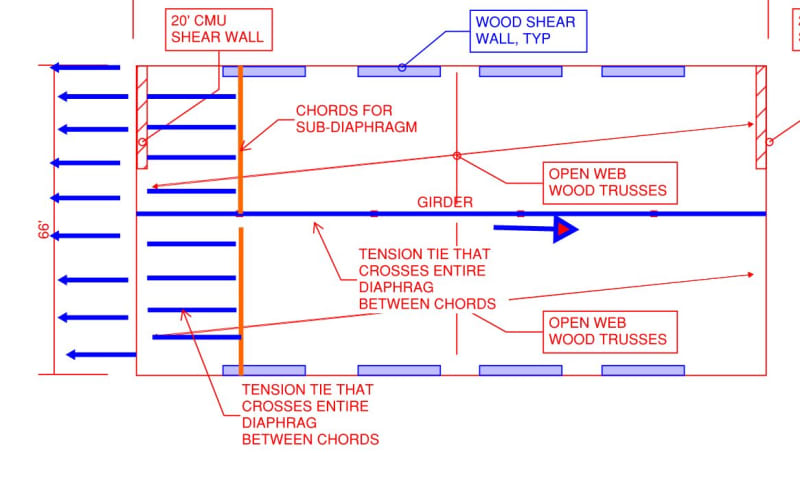Hello,
I have a project with a rectangular building foot print of 66' x 120'. It has a wood diaphragm on the roof and wood (shear)walls in the long direction. In the short direction I have (2) 20' long CMU shear walls and wood framed walls for the remainder. The CMU shear walls are not centered in the building footprint. We are in SDC D, so my question relates to wall anchorage and sub-diaphragm. Currently I have no continuous cross ties in my diaphragm, so I am assuming my minimum sub-diaphragm length = 66/2.5 = 26.4'. If I do add a continuous cross tie at the mid point of my diaphragm it would not even bear on the CMU wall, and it's required anchorage force would be minimal since it would just be the trib of a wood wall, right? I guess my main question is how do you determine required sub-diaphragm length in partial length CMU wall buildings? For my instance, would it be acceptable to say my sub-diaphragm only needs to be the length of my wall (not the distance between the diaphragm chords) divided by 2.5? That doesn't seem right either, but the alternative isn't very intuitive to me at least. All comments appreciated.
SGS
I have a project with a rectangular building foot print of 66' x 120'. It has a wood diaphragm on the roof and wood (shear)walls in the long direction. In the short direction I have (2) 20' long CMU shear walls and wood framed walls for the remainder. The CMU shear walls are not centered in the building footprint. We are in SDC D, so my question relates to wall anchorage and sub-diaphragm. Currently I have no continuous cross ties in my diaphragm, so I am assuming my minimum sub-diaphragm length = 66/2.5 = 26.4'. If I do add a continuous cross tie at the mid point of my diaphragm it would not even bear on the CMU wall, and it's required anchorage force would be minimal since it would just be the trib of a wood wall, right? I guess my main question is how do you determine required sub-diaphragm length in partial length CMU wall buildings? For my instance, would it be acceptable to say my sub-diaphragm only needs to be the length of my wall (not the distance between the diaphragm chords) divided by 2.5? That doesn't seem right either, but the alternative isn't very intuitive to me at least. All comments appreciated.
SGS

